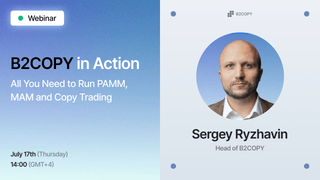Forex, Crypto & CFD Prime of Prime Liquidity Provider
SaaS WhiteLabel Solutions for Brokers, Banks, Exchanges & Payment Providers
Liquidity Provision
Turnkey Solutions
Explore all Products
B2TRADER
Trading Platform. Multi-market and multi-asset trading solution for FOREX, CRYPTO, Perpetual Futures, and CFD.
B2CORE
Forex CRM including Affiliate tools, mobile access, and instant spot conversion — all in One.
B2COPY
Copy Trading solution with 7-day launch and built-in support for strategy mirroring.
B2CONNECT
Connectivity Bridge to multiple crypto exchanges and LPs. Adjusted liquidity pool for crypto business.
PAMM
PAMM platform enabling fund creation and profit-sharing within your brokerage.
MAM
MAM platform to manage multiple accounts, allocate trades, and execute block orders.
Professionals
Years
Licenses
Offices
Customer Support
Learn more about the Company
and our Expertise
Get Started
Our team will present the solution, demonstrate
demo-cases, provide a commercial offer
Insights
Subscribe to Our Youtube Channel

The Network Effect. How Copy Trading Amplifies Brokerage Growth

B2COPY in Action: All You Need to Run PAMM, MAM and Copy Trading | Webinar

Diving Deep Into Brokerage and Trading Technology with B2BROKER CEO and CBO | Podcast

Beyond Aggregation: Strategic Liquidity Solutions Powered by B2CONNECT | Webinar
We’ll Telegram You
Explore Our Library
Our Offices
Media About Us
B2BROKER Expands Liquidity with Two New Equity Indices

B2BINPAY’s version 20 offers improved functionality, making crypto payments faster and more secure with broader blockchain support and enhanced transaction capabilities.

B2BROKER’s B2COPY Fully Integrates With Spotware’s cTrader

B2BROKER’s $5 million investment into B2TRADER aims to revolutionize brokerage services with advanced features, increasing efficiency for traders.

Get Started
Our team will present the solution, demonstrate
demo-cases, provide a commercial offer


